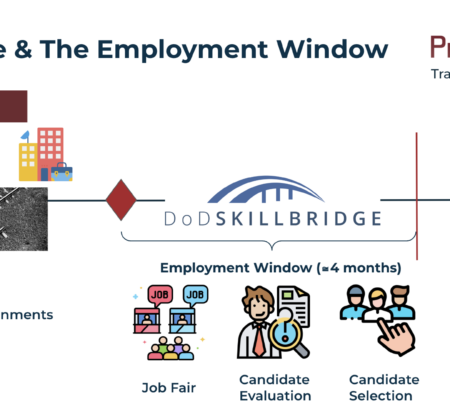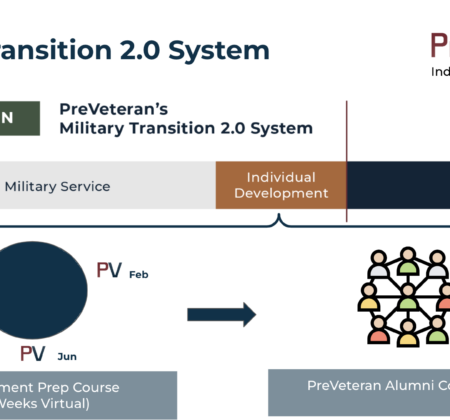This article was published in Military.com. Article link can be found below article.
Successfully transitioning from the military to a successful, well-paying civilian career is all about how you think about your transition. It’s all in your mindset, says PreVeteran founder Jason Anderson; you just need to change the way you think and align yourself to the private sector.
He knows what he’s talking about, because he has the experience and research to back him up.
Anderson is an Air Force Academy graduate, a former C-130 Hercules pilot with two decades of service, a small business owner and employee in the civilian aerospace industry. In the years following his separation, he took stock of the thoughts, emotions and actions that consumed him during his transition.
He founded PreVeteran, a research-based transition assistance program designed to help separating service members know their value, successfully operate in the civilian world and find meaningful jobs.
Seeking answers, he looked into different academic disciplines, including psychology and sociology, but ended up landing on cognitive neuroscience because, to him, nothing is more profoundly individual than how one’s brain processes information to make decisions. In fact, to develop this portion of the program, he hired a cognitive neuroscientist for a year to gain a deeper understanding of how humans think.
He applied those findings to the PreVeteran program, “Transition 2.0.”
The military’s current Transition Assistance Program, called TAP, is part of every departing service member’s military separation checklist. For many years, it was a weeklong class, designed to teach soon-to-be civilians about job searching, VA benefits, other benefits they get as they leave the military and more.
In 2019, TAP became available to service members 365 days before their date of separation. It helps them translate their military skills to the civilian world, and includes a day of benefits instruction from the Department of Veterans Affairs and a day of instruction on educational, employment or entrepreneurial career tracks.
Anderson calls the Department of Defense TAP classes “Transition 1.0.”
“TAP has been around since 1991,” Anderson tells Military.com. “They’ve changed it since then; the program and its outcomes are similar. It’s a good program, but they try to put too much into a short program. They throw all this information, all these resources in and hope that some of it sticks.”
Anderson notes that surveys and studies performed in recent years, including those years since TAP’s overhaul in 2019, revealed widespread veteran unemployment, underemployment and lower pay for veterans. Fifty percent of veterans are still leaving their first post-military job within the first year, with 65% leaving within two years, figures backed by Syracuse University’s Institute for Veterans and Military Families.
“That’s been the case for the past 30 years,” says Anderson. “This is not a new phenomenon.”
PreVeteran’s Transition 2.0 is based on cognitive neuroscience principles whose methodology is being validated by a researcher at Texas A&M University. It’s an individually tailored, holistic method that provides veterans with the framework and tools to help service members preventatively adapt to the civilian world before they leave the military.
Anderson says this individual focus will allow them to find the industry, company, role and level of employment that will be a good fit for them. Veterans need this level of specificity, because the private sector needs a specialist, and this is how they advertise positions on their job boards.
Without going through this training, the military members, who’ve never seen a job board before, do not understand how that role aids the profit-making enterprise.
“Transition 1.0 is a group-focused system,” Anderson says. “It can really complicate individual thinking. Thoughts drive behaviors, which drive actions and drive outcomes.The group focus is guiding the individual through an extremely complex landscape, and it can confuse an individual’s thoughts, actions and behaviors. It’s going to create bad outcomes.”
If the service member has never transitioned before, which is true for the vast majority of separating troops, they have no experience from which to draw. Since they’re still looking for clarity, Anderson says, they will draw conclusions from anywhere they can. The result is a “brain gap” that will search for answers from anywhere, including social media influencers, who might just be trying to sell them something.
“They’re a Hoover,” Anderson says. “Essentially, they’re pulling in all this external information from research and from influencers. The lack of memory leads to the brain going to a survival function of, ‘Hey, I need to figure this out.'”
In the end, the military member will revert to what they know: the military mindset. The civilian world, Anderson says, does not work that way.
“They need to fundamentally change,” he says. “They have to become aligned to the private sector’s needs. You need time to change and time to acclimate yourself to the private sector’s needs and wants.”
Over PreVeteran’s five-week Employment Prep Course, students can begin developing that transition 2.0 mindset. Traditional TAP training teaches things like translating military skills for the civilian world, a process Anderson calls “tactical,” whereas PreVeteran’s training allows the individual to engage in more empowering strategic thinking.
“The first step of preparation should be done before you do the GI Bill, a SkillBridge program or get a job,” he says. “Otherwise, if you haven’t done that first step, everything after it is totally inefficient or won’t work.”
To learn more about PreVeteran and Transition 2.0, take the Employment Readiness Quiz or read the 5-Step Guide for Getting the Job You Want. You can also sign up for a free Employment Prep Workshop on June 16, 2022, via LinkedIn or Online. Visit the PreVeteran website courses page for regular Employment Prep or salary negotiation classes, each just $497.
— Blake Stilwell can be reached at blake.stilwell@military.com. He can also be found on Twitter @blakestilwell or on Facebook.



